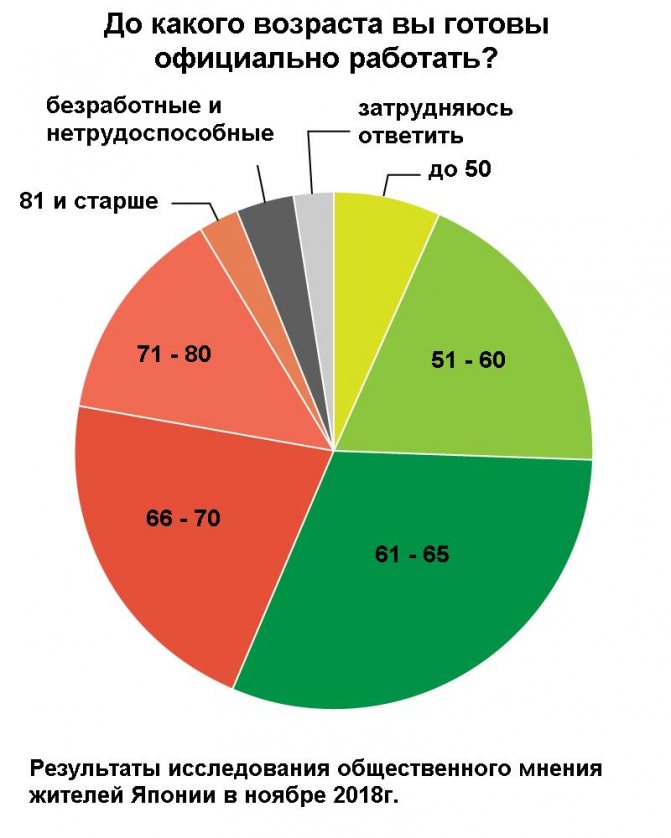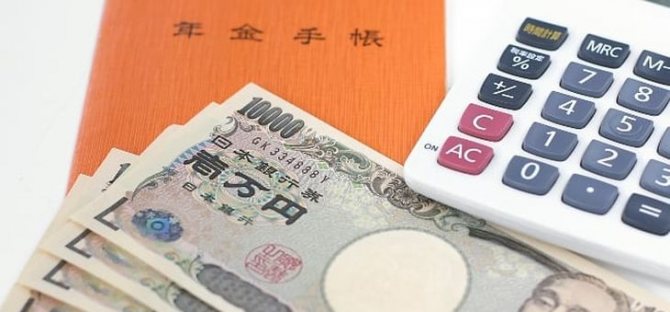The Japanese are a nation of long-livers. On average, the life expectancy of Japanese people is more than 80 years, and the retirement age is 70 years. Most retirees continue to work and have a high total income. This allows them to travel, buy cars, and pay for rented housing. The standard of living of Japanese pensioners is comparable to that of Sweden, Denmark, Switzerland and Norway.
Features of the Japanese pension system
In Japan, pension payments were approved at the legislative level in 1945. Then they were called public: a third of the amount was paid by the state fund, the rest depended on the contributions of entrepreneurs and the working population. Payments differed from month to month, were accrued inconsistently, and often with delays. In 1986 The Japanese government established the Social Security Fund. It is a savings system - financial contributions are automatically transferred to fund accounts and distributed for pension payments. The money remaining after payments is not withdrawn, but goes into reserve.
Gradually, the organization's assets became equivalent to those of a US pension fund. Given the difference in population size between these countries, retirees in Japan are effectively protected from the financial crisis. The fund's financial reserve is sufficient for continuous payments for 5 years.
The social pension is constantly increasing, but it is still not enough to fully satisfy all needs. Japanese retirees are following an established global trend: putting aside personal savings. The residents of the country themselves and the government agree that the modern system of government payments can be reformed in the future. Most pensioners agree to switch to a private savings system: set aside part of the money they earn, on which they will live in old age. At the same time, government payments will not be completely abolished in order to ensure a living wage for people with low incomes.
General information
Elderly people in the Land of the Rising Sun began receiving regular financial assistance from the state in 1942. A third of payments under the “Public Pension” program were made from the state budget. The remaining part was formed through contributions from employed citizens, as well as individual entrepreneurs.
In fact, Japan's pension system began to work only after the reforms carried out in 1954, when the country's economy, which had emerged from the post-war crisis, stabilized. The norms of the updated Japanese legislation guaranteed monthly payments to all members of the population who are working and have crossed the age limit of 60 years.
The Pension Fund (PF) was subsidized by the state. The bulk of the fund included contributions from employers and working citizens (in a 50/50 ratio).
The rate of tax contributions to the Pension Fund gradually increased:
- in 1961, 3.5% was levied on wages;
- by 1996 the rate had increased to 16.5%.
Today, the assets of the Japan Pension Fund exceed 170 trillion yen ($1.61 trillion).
Types of old-age pensions in Japan
There are three types of pension benefits, or nenkin, in Japan:
- professional;
- state;
- one-time benefit.
Everyone who is officially employed and works 30 hours a week, which is 85% of the country’s entire working-age population, will receive a professional pension. Their future payments are made up of monthly payroll deductions and contributions from their employers. The rate of such contributions is 18.3% and is divided equally between the employee and his company.
The state pension is paid to the self-employed and those who work in enterprises with fewer than 5 employees. To receive a future pension, these workers make fixed monthly contributions to a pension fund. In 2020 every month they pay 16,410 yen or $150.
The main difference between one type of pension and another is that the amounts of contributions for the self-employed and employees of small enterprises are less than those made by applicants for a professional pension and their employers. Accordingly, this will also affect the amount of future old-age payments.
Also, upon retirement, a person receives a lump sum benefit. Its amount is calculated using the formula: salary multiplied by the number of years worked. One-time financial assistance is sponsored not by the state, but by the management of the enterprise.
How to apply for a pension for a foreigner
A foreigner who pays contributions to the national pension system when leaving the country can receive a lump sum payment, but not more than for 3 years, or can leave the money in the Japanese fund for later use in case of retirement. In this case, the accumulated funds can only be used if an appropriate agreement has been concluded between the countries. Today, Japan has international agreements in the field of pensions with 18 countries; Russia is not on this list.
The amount of insurance contributions paid under the Kosei Nenkin system (in other words, the labor part of the pension) can also be claimed when leaving the country.
Here you need to remember the following:
- if a resident has lived in Japan and paid pension contributions for less than 3 years, then when leaving the country he can claim a full refund of his (and those transferred by the employer) funds, such funds can be received no later than 2 years from the date of departure from Japan.
- if the period of residence is from 3 to 9 years, then upon departure you can only count on the amounts of transferred contributions for the last 3 years; such funds can be received no later than 2 years after leaving Japan
- If a foreigner has lived in Japan, worked full time and paid contributions to the pension system for 10 years or more, then when leaving the country he will not be paid a lump sum. There are only 2 ways to receive pension payments: if he lives in one of the 18 countries with which international agreements have been concluded, then the funds can be transferred to the pension fund of his country. If there is no such agreement, then you will have to wait until retirement age and apply for a pension. In this case, the Japanese pension can be established regardless of where the foreigner will live on the day he reaches retirement age.
You can receive a lump sum pension payment only after leaving Japan. To do this, it is necessary to leave an authorized representative in Japan, who can fill out all the necessary documents on behalf of the principal.
You can also apply for payment processing yourself before leaving, providing the account number issued in your country. Payment will be made only after you return home. The second option takes longer.
On the official website of the Japan Pension Fund you can find out the procedure for applying for a pension, including a lump sum payment, and obtain the necessary forms there.
Address: Japan Pension Service, 3-5-24, Takaido-nishi, Suginami-ku, Tokyo 168 8505 Japan
You can find a list of addresses of the Japan Pension Service at the following link: https://www.nenkin.go.jp/international/index.html You can also get the necessary information by phone by calling the special number “NENKIN Dial”. When asking for help, Have your pension book (your pension number) with you.
Let us say right away that pensions in Japan for foreigners are paid only to those citizens of other countries who have made insurance contributions to the Pension Fund and who have a Japanese residence permit. When leaving Japan, they can apply for a lump sum payment. The existing limitation will be discussed below.
But the option of leaving money in the Japanese Pension Fund for use after retirement in the Russian Federation is not feasible in this case. The fact is that there is no agreement between Russia and Japan in the field of pension provision.
In addition, when leaving Japan, you can request to receive the amount of insurance premiums paid under the “kosei nenkin” system (as the labor part of the pension is called in Japanese in Russian transcription).
At what age do people retire in Japan?
The retirement age for men and women is the same – 65 years. But you can end your working life earlier – at 60 – or continue working until you are 70 years old.
The following persons have the right to early retirement:
- employed in hazardous work;
- having special merits;
- injured at work.
To qualify for a pension, an employee must have 10 years of work experience and pay insurance contributions while working.
Due to the increase in life expectancy of the population and the decline in the birth rate, the Japanese government is seriously thinking about increasing the retirement age to 71 years. The authorities explain this for a number of reasons:
- one of the best healthcare systems in the world allows the Japanese to be physically and mentally healthy into old age;
- many pensioners are ready to continue working after 60 years;
- after retirement, most Japanese citizens remain socially active for a long time;
- The country's population is falling sharply, and in the next 40 years it is predicted to decline from 127 million to 88 million inhabitants, and accordingly, there will be a reduction in labor resources.
According to statistics, 8 million workers over 65 years of age make up about 12% of the country’s total labor force.

Amount of payments to Japanese pensioners
The size of old-age pension payments depends on a number of parameters:
- Main part. About 73% of the total amount is accrued monthly from the Pension Fund if a person retires at the age of 65. If you stop working at age 60, the amount of financial assistance is reduced by 30%. The average value of the social pension fluctuates around 74.5 thousand yen ($700).
- Professional pension. An important point regarding the calculation of financial assistance of this type is whether a person belongs to a certain category of workers. For example, for those who are interested in what kind of pension civil servants have in Japan, let us inform you: they receive approximately 2/5 of their salary. Savings for subsequent cash assistance in old age are formed from employee contributions to the Pension Fund in the amount of 5% of earnings. In addition, the employer transfers money to his employee’s account in the Pension Fund.
- One-time benefit. The payment amount is calculated using the formula:
SV = EO × KOL, where
SV – payment amount, required parameter;
EO – monthly salary;
KOL – number of years worked at the company.
Considering that a person in old age does not need to spend money on raising children or purchasing housing, such provision for old age can be considered quite worthy.
Against this background, it is not at all surprising that the most expensive trading enterprises in the Land of the Rising Sun with goods of well-known brands are aimed at elderly buyers. After all, their solvency is at a high level.
Thanks to the inherent thrift mentality of the Japanese, over the years, pensioners, as a rule, have managed to create their own financial savings. In combination with a pension, this allows older people to acquire even things that they previously denied themselves.
Any person living and working in Japan, regardless of citizenship and nationality, must be included in the state pension system. This means that all persons between 20 and 59 years of age are required to enroll in national insurance and pay contributions.
Can a foreigner refuse to pay insurance premiums? - No. This is the responsibility of everyone living in Japan. If I’m not confused, even when coming to study at a language school, insurance premiums are withheld from students. Disabled and unemployed people can apply to their local municipality every year for a reduction in their insurance premiums.
Payment of contributions for the formation of a national pension is mandatory and does not depend on the fact of work. The National Pension was first established in 1961 for the self-employed and non-working population. Citizens independently made fixed payments to form their future pension. At first, contributions were insignificant in amount, with a gradual increase and, for the interest of the population, were co-financed by the state.
There are 3 types of pension relationships that everyone working in Japan must enter into, regardless of whether the job is permanent or temporary. The old-age pension consists of two parts 国民年金 / Kokumin nenkin the basic national pension and 厚生年金 / Kōsei nenkin, the labor part of the pension.
- Basic national pension 国民年金 / Kokumin nenkin / national pension plan. It is paid to all citizens who have reached retirement age, regardless of whether they worked or not, but subject to mandatory monthly transfer of pension contributions. As a rule, this part of the pension is received by people who had their own business. The same type of pension also applies to foreigners working in Japan. When returning home, part of the pension contributions may be returned (but more on that below).
- The labor part of the pension 厚生年金 / Kōsei nenkin / employee pension insurance plan is established for persons who worked in hired work and received wages from which pension contributions were withheld. The labor part is added to the basic national pension. At the same time, it was said above that working citizens are divided into two parts: those working in private companies/kosei nenkin and in state/municipal (including teachers) institutions/kyosei nenkin. Taking into account the fact that their percentage of pension contributions is different, ultimately their pension amounts are also different.
So, from the above it follows that persons covered by the Kōsei nenkin pension system pay more pension taxes throughout their lives, but their pension is also much higher.
A foreigner who pays insurance premiums under the Kosei Nenkin system can count on a partial refund of money in a lump sum if leaving Japan. To do this, you should contact the regional offices of the state insurance system.
After registration in the state insurance system, a 年金手帳 / Nenkin-techō - pension book is issued. From this moment on, it should be kept, since it will be needed at the moment when it is necessary to decide on the establishment or payment of a pension. Of course, if lost, it will be restored, but it is still recommended to have the original.
As already written above, there are big problems in Japan: society is aging rapidly, the percentage of the working-age population is rapidly decreasing, and therefore the pension system is in a state of constant change. First, the retirement age was increased, then mandatory fixed pension payments to the national pension plan and the percentage of transfer of insurance pensions in the employee pension insurance plan were increased.
There is talk about increasing the (mandatory) retirement age to 70 years, since today's generation of pensioners is ready to continue working after 65 years.

On the website of the Japanese government you can get official information about the conditions of pension provision, including in Russian.
Retirement age in different countries of the world in 2020 (table)
Below is a table of the retirement age in countries around the world with comments on plans for future adjustment of these values, as well as, for comparison, the life expectancy of citizens of these countries (data collected from open sources):
| A country | Retirement age in 2020 | Life expectancy (according to Rosstat for 2015/2016) | Comments | ||
| Husband. | Women | Husband. | Women | ||
| Austria | 65 | 60 | 79,6 | 84,2 | From 2014 for women the value increases to 65 years (by 2033) |
| Azerbaijan | 64 | 61 | 72,8 | 77,6 | The value increases by six months per year until the age of 65 (previously it was 63 and 60) |
| Armenia | 63 | 71,6 | 78,3 | ||
| Rep. Belarus | 61 | 56 | 68,9 | 79 | From 2020 it increases by six months per year to 63 and 58 (from 60 and 55) |
| Belgium | 65 | 78,8 | 83,9 | An increase is planned from 2025. up to 66 years, and from 2030 - up to 67 years. | |
| Bulgaria | 63 | 60 | 71,1 | 78,0 | |
| Great Britain | 65 | 79,8 | 83,5 | They plan to increase it to 68 years | |
| Hungary | 62 | 72,4 | 79,7 | ||
| Germany | 65,5 | 65,5 | 78,7 | 83,6 | Since 2012, it has been increased to 67 years by 1-2 months per year (depending on the year of birth). Was 65 years old. |
| Israel | 67 | 62 | 80,1 | 84,1 | Plans to increase to 64 years |
| Italy | 66 years 7 months | 81,1 | 86,0 | Since 2012, the age has been increased to 67 by 2021 (previously it was 65 and 60) | |
| Kazakhstan | 63 | 58,5 | 68,1 | 76,6 | From 2020, it will be increased by six months per year to 63 years. |
| Canada | 65 | 80,2 | 84,1 | ||
| Kyrgyz Republic | 63 | 58 | 67,0 | 75,1 | |
| Latvia | 63,25 | 69,1 | 79,4 | Since 2014, it has been increased annually by 3 months. before reaching 65 years of age (was 62) | |
| Lithuania | 63,5 | 62 | 69,9 | 80,6 | Since 2011, it has been gradually increased to 65 years by 2026 (from 62.5 and 60) |
| Moldova | 62 | 57 | 68,1 | 76,2 | |
| Norway | 67 | 80,1 | 84,2 | ||
| Russia | 60,5 | 55,5 | 66,5 | 77,1 | From 2020, the retirement age increases to 65 and 60 years, respectively. |
| Romania | 63 | 58 | 71,4 | 78,7 | |
| USA | 67 | 76,4 | 81,2 | ||
| Tajikistan | 63 | 58 | 71,9 | 75,7 | |
| Uzbekistan | 60 | 55 | 71,4 | 76,2 | |
| Ukraine | 60 | 58,5 | 66,7 | 76,5 | Women will be gradually increased to 60 years of age by 2021 |
| France | 62,5 | 79,5 | 86,0 | Planned to increase to 67 years | |
| Estonia | 63,5 | 72,4 | 82,1 | Gradually increases until age 65 in 2026 | |
| Japan | 65 | 80,8 | 87,1 | ||
As can be seen from the table presented, in many foreign countries there is a common trend when the retirement age for men and women is set at the same level . In most countries of the world this value is 65 years or more . In some of these states, new standards have already been enshrined, in others the importance is gradually increasing, and some are just starting to reform the pension system, as, for example, in Russia.
This increase is primarily based on the increase in life expectancy of citizens , which causes an increase in the number of pensioners and an increase in the tax burden on the working population. Therefore, the authorities are adjusting the boundaries of the population’s working capacity in order to balance the country’s pension system.
However, no unambiguous conclusions can be drawn based only on established retirement age standards and life expectancy data. It must be borne in mind that pension systems in different countries are structured differently . There is no universal system that can be used in every state.
In each individual country, the pension system is adjusted to a number of constantly changing factors:
- ratio of working and non-working citizens;
- the state of the economy, government savings, tax system, labor market;
- and of course, the increase in life expectancy of citizens.









